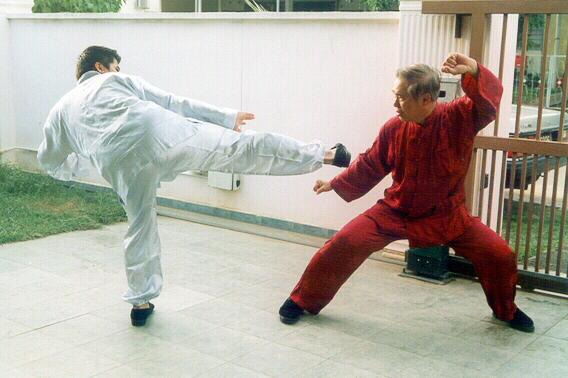COMBAT EFFICIENCY, HEALTH AND SPIRITUAL CULTIVATION

A pattern from Wahnam Taijiquan
Question
I understand that the goal of all martial arts is combat efficiency. If this is the case, and all martial arts have the same goal, and can all be made to work for fighting, how do I choose which one to do?
— James, USA
Answer
Yes, the goal of all martial art is combat efficiency. But you and many other people may be surprised at the fact that more than 80% of martial artists of any style today, including advanced practitioners like black-belts and masters, have no combat efficiency, though many of them are good at punching and kicking others and enduring punches and kicks from others!
If they were combat efficient they would not be so randomly punched and kicked. Indeed, to be punched and kicked in free sparring is so common today that some instructors sometimes ask their students how they could learn a martial art if they could not stand some punches and kicks. This is ridiculous. The very fact of learning any martial art is not to be punched and kicked at all! Yet, many people submit themselves to be routinely punched and kicked, while they punch and kick their friends, when learning what they think is a martial art as a hobby, which is meant to give them pleasure, not pain and injury.
Genuine martial arts where practitioners can defend themselves are rare today. Even amongst these rare martial arts, there are different ways of attack and defence. You may, for example, strike your opponent with your hand, or kick him, or throw him onto the floor, or hold him in a lock. Hence, different types of martial art developed, such as Karate, Taekwondo, Judo and Aikido.
There are also different ways of using the same kind of attack. In striking an opponent, for example, you may use a level fist as in Karate, or a phoenix-eye fist or a palm as in some styles of kungfu. When kicking an opponent, you may kick high at his face, not caring that you expose your groin, or cover his hands and kick at his groin with the in-step of your foot often without him knowing where the kick comes from as in Shaolin Kungfu. Hence, different types of martial art evolved.
On the other hand, there are also different ways to respond to the same attack. When an opponent kicks at your middle level, for example, you may block the kick with your hand and move in to strike him with your punch as in Karate. Or you may, without moving your feet, shift your body slightly backward to avoid the kick, and simultaneously grip his kicking leg and dislocate his ankle as in Taijiquan.
This difference leads to the development of different martial arts which serve different purposes in combat. A woman or a physically weaker person, for example, would be at a disadvantage if she blocks a kicking leg, but there is no disadvantage in the second response where she avoids the kicks and simultaneously grips the leg. The blocking response is also more risky.
The two different responses show a different development of skills. The first response is crude, whereas the second response is sophisticated. Herein is another reason why there are different martial arts. Initially fighting techniques were straightforward and crude, but over time they became refined and sophisticated.
While all martial arts are meant for effective fighting, this is not the only function of some martial arts. Depending on their functions, martial arts may be divided into three classes.
Third class martial arts are those that are meant only for fighting. Their training is sometimes detrimental to health. To avoid hurting the sensitivities of their practitioners, I would refrain form giving examples of these martial arts.
Second class martial arts are those that are meant for fighting as well as for improving health. I would leave you to figure out some examples.
First class martial arts are those that are meant for effective fighting, health promotion and spiritual cultivation. Shaolin Kungfu and Taijiquan are two outstanding examples.
Of course I refer to genuine Shaolin Kungfu and genuine Taijiquan, which are rare today. If you practice Shaolin or Taijiquan forms for demonstration, and do not know how to apply them for combat, you do not even practice a martial art, you practice "flowery fists and embroidery kicks". If you practice Shaolin and Taijiquan forms but use kick-boxing or other martial systems for fighting, then yours is a third-class martial art.
Some practitioners of third class martial arts may say that their arts promote health and contribute to spiritual cultivation. This shows their blind loyalty or ignorance, or both. They are so blindly loyal to their arts that they claim benefits when these benefits are not present. They are ignorant that the more they train their art, the more unhealthy they become.
They are also ignorant of what spiritual cultivation means. It means cultivating their spirit. If they remain, or worse still become, stressful, angry, agitated, nervous or depressed, they have not cultivated their spirit.
The explanation here not only shows that all martial arts are not the same, but also provides you with a sound philosophical understand to make a good choice if you wish to practice a martial art. Without this explanation, it is likely that you may fail to practice a martial art though you think you do, because you can only punch and kick each other if you practice free sparring, but cannot defend yourself.
The above is taken from Question 1 of May 2015 Part 3 of the Selection of Questions and Answers.
LINKS
Courses and Classes
